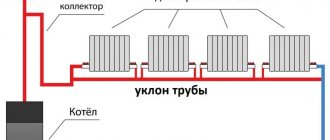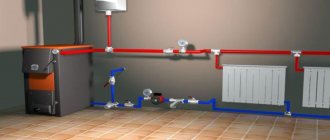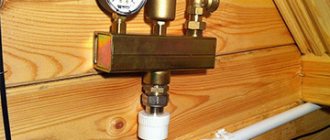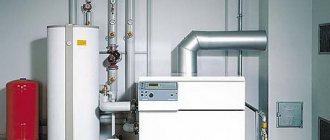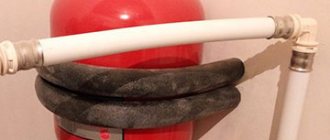When faced with repair work, going on a long trip or becoming a victim of an emergency, many people wonder whether it is necessary to drain the water from the heating system? In most cases, the answer is positive, although there are also situations where it is possible to fix a problem or make repairs with radiators filled with liquid.
Although the draining procedure is not particularly complicated, following the operating rules is an important nuance. If you violate the procedure, you can flood the floors in your own home with water. And if the drainage is carried out in a multi-story building, then neighbors may also suffer from incorrect actions.
Open and closed heating systems: filling principle
The open system is equipped with an expansion tank at its highest point. The surface of the coolant fluid in it is in direct contact with atmospheric air. The closed system is equipped with a membrane expansion tank, hermetically sealed from the atmosphere.
Heating systems of any type can be filled as follows:
- tap water supplied to the lowest point of the system - through the make-up valve;
- water (distilled) or antifreeze, supplying liquid from a container (well, reservoir):
- by pouring manually and/or using a pump to the top point (fitting under the air vent or through an open expansion tank);
- pumping through the lowest point - the make-up inlet.
Many homeowners know the simplest (and worst!) way to fill open systems through an expansion tank. Water/antifreeze is poured inside with breaks to release air. It is not recommended to repeat this method in closed systems using the pipes of the upper air vents. The air that initially fills the system passes up through the layer of water being poured, dissolving in it. Air locks that prevent the flow of water through pipes and radiators will be guaranteed.
Then how to fill a closed heating system? The recommended method of filling any heating systems is to supply fluid under pressure (from a water supply or container via a pump) through the bottom fill valve.
Location of the heating system make-up unit.
Best answers
Konstantin Sukhorukov:
Only the heating engineer did not say what would happen to the boiler heat exchanger from the effects of antifreeze. If you want to use anti-freeze, then use liquids based on propylene glycol. And you can pump it without using a water pump, using a regular car pump and a lockable container with two fittings.
Larisa:
pump and hose
Alexander Bakushev:
open the emergency light and fill it until it runs out!
Andrey:
Pump a small container in the usual way and into it a cheap submersible pump, through a hose to the make-up tap, control the pressure using a standard pressure gauge, bleed air, pump and pump. Pre-pressurize the system with network water, check its operation under temperature changes. Evaporation of antifreeze and antifreeze inside a living space is goodbye to health and vision. for these reasons, fill it with an aqueous solution of drinking alcohol (vodka). Moreover, if the system is new and its volume is not very large, get a supply of the strategic product.
Bely Oleg:
Make two fittings in the canister, pour in anti-freeze, one hose goes to the boiler, and pump air into the other with a compressor from the refrigerator. The compressor from the refrigerator presses up to 8 bar - this is definitely enough for you. Productivity is just low. But they cannot pump any electrically conductive liquids - the windings there are not protected in any way...
Denisochka:
Where did the need for glycol coolant come from? When using it, heat transfer is reduced and boiler maintenance becomes more difficult, especially if the boiler is double-circuit with one heat exchanger. For almost any heating system, the best coolant is water.
When filling with coolant
There are only two known situations that require this technological operation:
- putting heating into operation (at the beginning of the heating season);
- restart after repair work.
Typically, coolant water is drained in late spring for two reasons:
- Water inevitably becomes contaminated with corrosion products (inside radiators, metal-plastic and polypropylene pipes are not susceptible to it). If you leave old water for the new season, you risk breaking the circulation pump with solid contaminants.
- Flooded systems of country houses that have not been started can “defrost” during a sudden cold snap - such cases are not uncommon. In this sense, antifreeze coolant is preferable. The high-quality composition has high anti-corrosion properties, increasing the drain interval to 5-6 years. There are known cases of uninterrupted heating operation with the same volume of antifreeze for 15-17 years. It is recommended to drain low-quality antifreeze after 2-3 years.
Pumping antifreeze into the heating system.
Why does the pressure jump?
If you notice a slow decline in performance, check the heat exchanger for leaks . Microcracks appear as a result of poor quality material and rapid wear. Frequent use of reagents when descaling also leads to dire consequences.
To avoid problems, install softening filters. They extract magnesium and potassium salts from the liquid. Cracks are difficult to detect. Sometimes they appear as green spots on the surface. In tubular radiators, the hole can be sealed by cold welding or soldering.
Bithermal heat exchangers suffer from water hammer, causing their tubes to burst. They cannot be repaired, only replaced.
The make-up valve is not sealed . Inspect the part for wear; it should be in the closed position. The valve is used in cases where the pressure in the circuit is low, there is not enough coolant and it needs to be pumped up. If faulty, replace the tap. If you want to leave the valve permanently in the “closed” position, then remove the valve, fill the holes with silicone, connect the valve in the closed position.
Filling technology: where to supply coolant
The necessary means are a container and a pump that creates the required pressure of the coolant liquid. Submersible type “Gnome” or “Kid” are quite suitable (popular with gardeners who use them for watering areas located above the levels of reservoirs). There is evidence of successful filling of closed systems using hand pumps - from those used for spraying protective solutions on garden crops, to specialized hand pumps used for pumping motor fuels or liquid chemicals from drums. Any heating circuit can be successfully filled by monitoring the pressure using a pressure gauge.
Filling the system with antifreeze using a submersible vibration pump.
The first step is to select the fluid entry point. If the pressure created by the pump raises the liquid to the top of the system, it should be connected at the lowest point of the boiler room - the coolant make-up pipe, cut into the “return” in front of the boiler. In addition to the make-up inlet, a structurally separate drain outlet is required (two different system components). The first is equipped with a valve (ball valve) and a check valve, the second - only with a valve (ball valve). If the lowest point of the system is the water drain fitting from the boiler, then you can drain/fill the system with water through it. Since a check valve is not installed behind the boiler drain (behind the drain at all), any shutdown of the pump will cause the pumped liquid to leak out - you need to quickly turn off the tap in front of the fitting.
Design of a typical drain/recharge unit.
Manual recharge scheme
The easiest way to replenish the heating circuit with water is to refill it manually. In order to fulfill it, it is necessary to stretch a pipeline from the city water supply and connect it to the return line of the heating network. A shut-off valve and a water purification filter are installed in this area.
The scheme functions perfectly in simple heat supply systems for one-story small-area households. The line is connected to the return line before the circulation electric pump, since this section has the lowest pressure and temperature of the network water.
For open heating networks, the make-up system organizes the supply of water not to the return, but directly to the expansion tank. To do this, you do not need to go into the attic to check the recharge level. According to the diagram, the expansion tank is connected with 3 independent terminals: make-up, supply and return pipelines.
The level in the tank is controlled by opening the valve on the control pipe directed to the sewer. When water flows after opening the valve, this means that the system is full; if not, the make-up valve opens, which is kept open until there is overflow from the control pipe.
Filling the system from below
So, let's get back to pumping fluid into the system. We use a container of suitable volume (a 200-liter plastic barrel works well). We lower a pump into it, creating the pressure required for pumping liquid no higher than 1.5 atm (typical value in the range of 1-1.2 atm). Such pressure requires the pump to create a pressure of 15 m (for the submersible “Malysh” it reaches 40 m).
Having filled the barrel with water, we start the pump, monitoring the liquid level, which should be located above its inlet pipe to prevent “airing”. The level drops - add water. Antifreeze should be pumped from a smaller container (bucket) so as not to immerse the submersible pump housing in the liquid (and then wash it) - just immerse the inlet pipe. You will have to add antifreeze frequently, turning off the pump periodically.
Filling the system is carried out with Mayevsky taps open on installed heating radiators with substitute containers for collecting water. When liquid comes out of all air vents, close the taps and continue the injection process.
We control the pressure using a pressure gauge (a boiler gauge will do). When its value exceeds the hydrostatic pressure, equal to the pressure in the liquid column height from the bottom to the top point of the system (a height of 5 m gives a static pressure of 0.5 atm), we continue to fill the system, monitoring with a pressure gauge the moment the pressure reaches the required value.
Pumping antifreeze with the “Malysh” pump.
Having filled the system, turn off the pump, open the air valves (the pressure will inevitably drop), and then pump up the water. We repeat the process several times, displacing air bubbles.
We complete the filling by inspecting the system for leaks. After the pump is turned off, the liquid in the hose connected to the outlet pipe is under pressure. If antifreeze was pumped in, first disconnect the hose from the pump inlet pipe and drain the liquid into a container, being careful not to drench the mechanism body.
Prerequisites for draining water
This procedure is carried out in the following cases:
- Replacement of heating equipment.
- Correction of boiler malfunctions and repair of individual mechanisms.
- Elimination of leaks at valve contacts, fittings and other pipes.
- Turning off the heating for a long time in winter.
- Replacing the coolant.
It is also important to know when not to perform such a bowel movement. There are three situations here:
- The boiler is not threatened by cold. You need to leave a little water in it to protect the interior from rust.
- There was stagnant water in the device because it had been turned off for some time. Stale water is renewed. To do this, fill the tank full several times.
- The boiler is still under warranty.
How to properly fill a closed heating system from above
If there is no electric pump, then filling the system, which has a height difference between the lower and upper points of 10 m, using a hand pump is a rather tedious procedure. In this case, the closed system can be filled through the upper point (for example, the connection fitting of an automatic air vent) by gravity with the drain valve open at the lower point until water begins to flow out of it. The drain valve closes, and at the bottom point of the system we have static pressure equal to the pressure in the liquid column up to the top point (at 10 m the pressure will be 1 atm).
Now you need to increase the pressure to a design level of no higher than 1.5 atm. We connect a regular watering hose about 1.5 meters long to any fitting of the system via a ball valve. We are coming up with an easily removable adapter for it to the hose of a regular car pump with a pressure gauge. We fill the vertically straightened hose with water, attach a pump through the adapter and pump water from the hose into the system with air. Close the ball valve. 3-5 repetitions of the process are enough to increase the initial static pressure at any point in the system by 0.5 atm. Avoid pumping air into it.
Injecting antifreeze with a hand pump.
Automatic refill
Automatic filling of networks is implemented in schemes with a low volume of make-up water through a pressure reducing valve, and in large heating networks through a pump.
The latter option is also applicable in situations where there are frequent network outages or the house has an autonomous source of water supply that does not have stable pressure in the network.
The primary sensor, which monitors the pressure drop in the return line before the cold coolant enters the boiler, sends a signal to the pump, which turns on and pumps out make-up water from the reserve tank or well.
This increases the pressure in the return network, triggering the limit pressure sensor, which turns off the pump.
Selecting pressure values in the system and expansion tank
The higher the operating pressure of the coolant, the less likely it is that air will enter the system. It is necessary to remember that the operating pressure is limited to the maximum permissible value for the heating boiler. If, when filling the system, a static pressure of 1.5 atm (15 m of water column) was reached, then the circulation pump with a pressure of 6 m of water. Art. will create a pressure of 15 + 6 = 21 m of water column at the entrance to the boiler.
Some types of boilers have a working pressure of about 2 atm = 20 m water column. Be careful not to overload the boiler heat exchanger with unacceptably high coolant pressure!
The membrane expansion tank is supplied with a factory set pressure of inert gas (nitrogen) in the gas cavity. Its common value is 1.5 atm (or bar, which is almost the same). This level can be raised by pumping air into the gas cavity with a hand pump.
Initially, the internal volume of the tank is completely occupied by nitrogen, the membrane is pressed against the body by the gas. That is why closed systems are usually filled to a pressure level of no higher than 1.5 atm (maximum 1.6 atm). Then, by installing the expansion tank on the “return” in front of the circulation pump, we will not get a change in its internal volume - the membrane will remain motionless. Heating the coolant will lead to an increase in its pressure, the membrane will move away from the tank body and compress the nitrogen. The gas pressure will increase, balancing the coolant pressure at a new static level.
Pressure levels in the expansion tank.
Filling the system to a pressure of 2 atm will allow the cold coolant to immediately press the membrane, which will also compress the nitrogen to a pressure of 2 atm. Heating water from 0 °C to 100 °C increases its volume by 4.33%. The additional volume of liquid must enter the expansion tank. The large volume of coolant in the system gives a large increase in its growth when heated. Too much initial pressure of the cold coolant will immediately use up the capacity of the expansion tank; it will not be enough to receive excess heated water (antifreeze). Therefore, it is important to fill the system to the correctly determined coolant pressure level. When filling the system with antifreeze, you need to remember that its coefficient of thermal expansion is greater than that of water, which requires the installation of a larger capacity expansion tank.
Conclusion
Filling closed heating systems is not just a standard final step before commissioning. Correct or incorrect execution of this step can seriously affect the performance of the system, in the worst case, even destroy it. Compliance with filling technology is the key to obtaining stable heating.
What to look for when buying basic characteristics
Productivity or feed
This is a value showing how much liquid the pump moves through itself per hour. Measured in m3/h. These data can be found in the technical document for the pump.
Multiply the volume of liquid in your pipes by three - and you will find out the approximate value of productivity.
Those. an approximate figure for a small village house will be 1 - 2 m3/h.
Performance of circulation pump Askoll ES2 70
A more accurate calculation is made using the formula:
Q=Qn/Dt
Q - desired feed
Qn – how many kilowatts of energy are needed for a given area (in kW)
Dt is the temperature difference between the boiler outlet and return.
Pressure
The second, no less important indicator. The more complex and longer the pipeline (the more turns, radiators, fittings and taps it has), the greater the pressure the pump should have.
It is clear that if there is insufficient pressure, the pump simply will not perform its functions, and if there is excessive pressure, noise will appear in the system from the rapid movement of liquid.
Pressure and flow characteristics of the pump
The pressure can be calculated using the following formula:
Hpu =R x L x ZF / 10000
R – losses caused by pipe friction (Pa/m)
L – pipeline length
ZF – coefficient for valve (1.7), fittings (1.3)
If all these calculations seem too difficult and confusing to you, there is a plan B. Buy a pump with a reserve of pressure and flow (which, of course, leads to unnecessary expenses), but you can always simply switch the unit to a lower speed if it is working too hard.
Connection size
The diameter of the pipes and the diameter of the inlet holes on the pump may not match. This, of course, can be corrected with the help of adapters, but it will be less troublesome if the section sizes are chosen to be the same. In the specifications for heating circulation pumps, the diameters are indicated in inches.
Power
Remember that your heating circulation pump will be turned on quite often and for a long time, so high power can be ruinous. Nowadays they make very economical units that consume electricity like a regular light bulb.
Selection of a circulation pump based on power parameters
Other nuances
Automation for the heating circulation pump (automatic regulator) will help save electricity. Then the pump will work “according to the needs” of the system.
When buying an imported pump on the Internet, it is a good idea to make sure that it operates on a 220 V network (and not 380, for example).
And look at the service life of the pump - it should not be less than 10 years.
